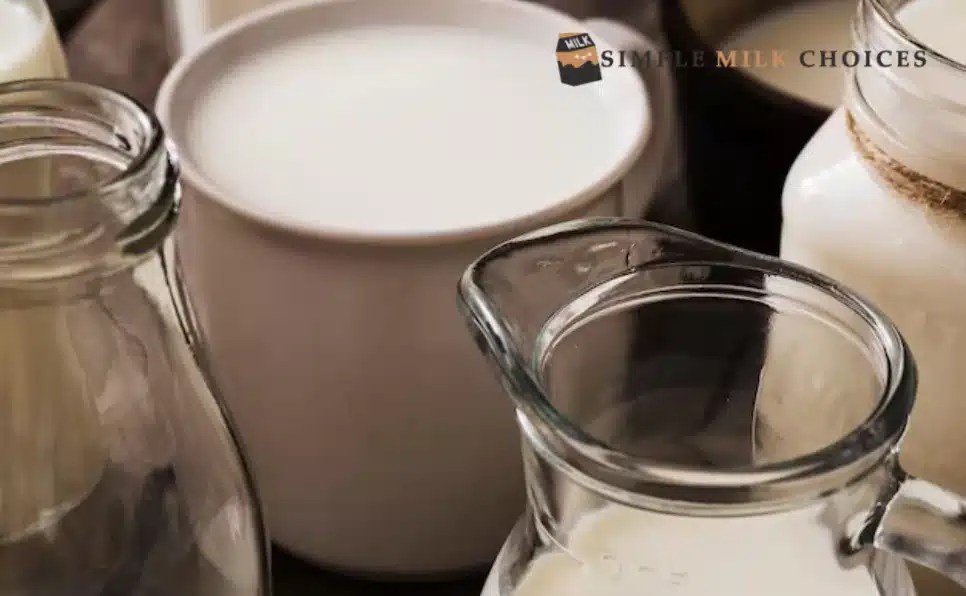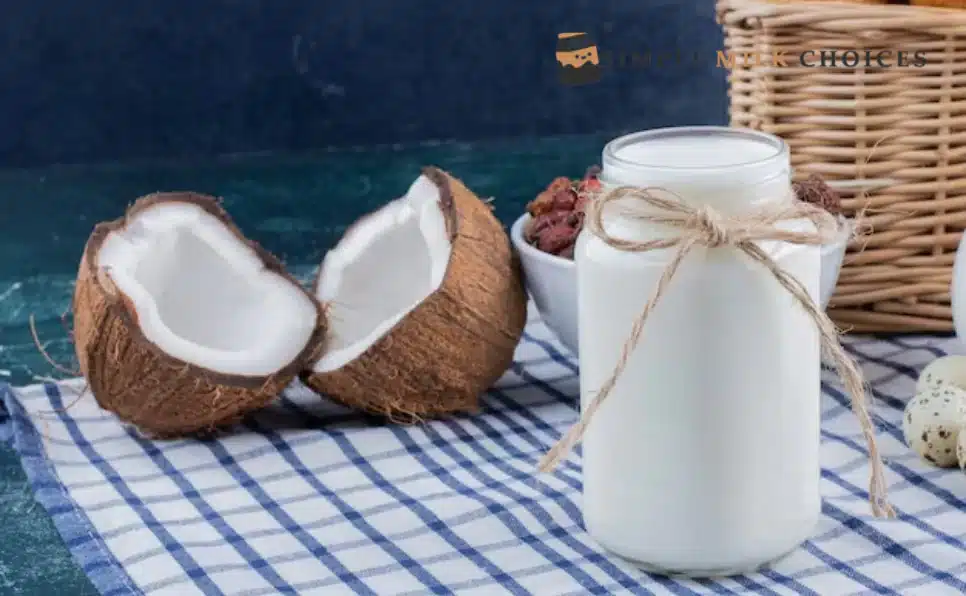Coconut milk is a versatile ingredient that gives a variety of dishes a distinctive flavor. However, it frequently prompts us to wonder: Can I freeze coconut milk? Additionally, what do we do with any remaining coconut milk? Let’s explore the world of coconut milk by looking into its ability to be frozen, clever ways to store leftovers and inventive uses.
People around the world use velvety coconut milk, obtained from mature coconut tissue, in various cooking styles. Its extravagance and particular taste make it a number one in both sweet and flavorful recipes. Knowing how to handle and store coconut milk is crucial to maintaining its quality. It ensures that you can enjoy the taste of coconut milk in your cooking.
Coconut milk is more than just a drink; it’s delicious on the palate. The milky goodness comes from grating and squeezing coconut flesh. Due to its distinctive flavor and adaptability, this creamy liquid is a common ingredient in numerous international cuisines.
Can Coconut Milk be Frozen?
You can freeze coconut milk, but it might undergo slight changes. At the point when you freeze it, it can isolate or get grainy. But that’s normal, so don’t worry! Simply give it a good shake or give it a shake to help it melt, and it should come back to normal.
Pour the coconut milk into freezer-safe containers before freezing it. Because liquids expand when they freeze, make sure these containers are airtight and leave some space at the top. It’s smarter to freeze it in more modest parts, so you can defrost only the sum you want each time. When it comes to keto-friendly options, remember that coconut milk is keto-friendly.
Keep in mind not to freeze coconut milk in its original can. Pour it instead into freezer-safe bags or containers. If you want to use it after it has frozen, you can either thaw it overnight in the fridge or quickly by putting the container in lukewarm water.
Therefore, freezing coconut milk is acceptable, though it may change slightly. After it has thawed, all you need to do to use it in your recipes is stir it around!
How to Freeze Coconut Milk?
It is possible to freeze coconut milk, but there are some things to know first. Begin by emptying the milk into impenetrable compartments, leaving some space for development. Seal them firmly and name them with the date. You can easily store coconut milk for later use by freezing it. An easy-to-understand explanation in detail follows:
Prepare the Coconut Milk
Pour the coconut milk into a container to begin storing it or if you have any leftovers. Because liquids expand when they freeze, ensure that the container has sufficient space at the top. Similar to when a soda can bulge when placed in the freezer!
Use Airtight Containers
Pick a compartment with a tight cover that seals well. This prevents freezer smells from entering the coconut milk and keeps it fresh.
Segment It Out
Ponder how much coconut milk you could use without a moment’s delay. Freezing coconut milk in small portions, like in ice cube trays or tiny containers, is the ideal method. This will allow you to melt just the right amount when you need it.
Name and Date
It’s similar to making a freezer map. You should write the date you froze the containers on them. It helps you remember when you should use them and put them in.
Keep It Frozen
Place the containers containing your coconut milk in the freezer after they have been labeled. Keep them in the coldest part, ordinarily towards the back.
Stay Away from the First Can
If you have any leftover coconut milk from an opened can, it is best not to freeze it in the can. Transfer it to a freezer-safe container instead.
When you are ready to use it, remove the frozen coconut milk from the freezer. Let it melt overnight in the fridge or a bowl of lukewarm water. Give it a delicate mix or shake in the wake of defrosting because it could look a little changed after freezing, yet it’s still great to utilize!
It’s as simple as that at all! You can freeze coconut milk to preserve its delicious flavors while maintaining its quality.
Related Article: Almond milk and its shelf life

How to Utilize All of the Remaining Coconut Milk?
Protecting Extra Coconut Milk
At the point when you have some coconut milk left, it’s vital to store it appropriately. Refrigerate it in a container that keeps out air. But, remember, coconut milk doesn’t keep going too long in the refrigerator, so use it within a couple of days.
Use an Airtight Container
Seal a clean container with the leftover coconut milk. This container ought to keep out air and any other flavors or smells.
Keep it Cold
Whenever you’ve put the coconut milk in the holder, try to store it in the ice chest. The milk is safe to consume because the low temperature stops the growth of any bacteria.
Pay Attention to Expiration Dates
Coconut milk does not last forever, even when stored in the refrigerator. It’s ideal to utilize it within a couple of days to ensure it tastes great and doesn’t ruin.
You can get the most out of leftover coconut milk and avoid wasting this delicious ingredient by storing it in a sealed container in the refrigerator and using it before it spoils!
Uses for Coconut Milk Leftovers from Cooking and Baking
Consider coconut milk to be a covert ingredient in your culinary endeavors! Using coconut milk in soups, stews, and curries enriches their flavor and creamy texture. For a tropical twist in baking, swap regular milk with coconut milk in cakes and muffins. Give it a try!
1. Smoothies and Beverages
Make your beverages seriously invigorating! Mix extra coconut milk with your natural product to prepare revitalizing smoothies. It gives them a tropical kick that is delightful and not the same as the standard thing.
2. Treats and Desserts
It’s time for a sweet treat! Use coconut milk to make yummy pastries like coconut-seasoned frozen yogurt or pudding. You could even use it to make a moist, delicate cake with just a little coconut flavor.
Remember that the rich flavor and creamy texture of coconut milk may improve anything you make. So, get creative and enjoy exploring these mouth-watering concepts!
Exploring the Multiple Uses of Frozen Coconut Milk
The process of restoring frozen coconut milk to its liquid state is called thawing. When frozen, coconut milk solidifies due to the cold temperature. Thawing is the process of turning it back into a liquid so you can use it in recipes.
To Thaw Out Frozen Coconut Milk
1. How to Use a Refrigerator?
The frozen coconut milk should be kept in the refrigerator for several hours or overnight. This sluggish technique permits the milk to defrost and get back to its fluid state gradually. It resembles allowing it to gradually heat up.
2. Method by Water Bath
If you want to defrost it quicker, you can put the fixed holder of frozen coconut milk in a bigger bowl or sink loaded up with tepid water. Ensure the compartment is firmly fixed to keep water from getting in. To help the milk thaw evenly, occasionally swirl the container in the water.
The objective is to take the frozen coconut milk back to its fluid structure so that it can be used in your cooking or recipes. The milk may have separated or become slightly grainy after thawing. That is fine! Before using it, simply give it a thorough stir or shake to bring it back together.
Related Article: Does Soy Milk Go Bad?
Utilizing Frozen Coconut Milk in Dishes
Utilizing frozen coconut milk in dishes resembles having a mysterious fixing that can make your food taste far superior! At the point when you freeze coconut milk and then defrost it later to use in recipes, it brings a smooth and somewhat sweet flavor to your dishes.
1. Soups and Curries
Imagine adding defrosted coconut milk to your number one curry or soup. They taste even better because it gives them a creamy, rich texture.
2. Dressings and Sauces
You can make astounding sauces and dressings by utilizing defrosted coconut milk. It gives your dishes a tropical twist and adds a lot of flavor.
3. Ice cream and Sundae
Frozen coconut milk can be used to make homemade ice cream and sundaes! They take on a delightful coconut flavor that makes them ideal as a cool treat in the summertime.
When used in cooking, thawed coconut milk adds a magical flavor. It makes your food taste better and more unique.

Advantages and Contemplations of Freezing Coconut Milk
Healthy Angles in the Wake of Freezing
At the point when we freeze coconut milk, it could change a tad. When it thaws, or when it returns to its normal temperature, the cold can cause the coconut milk to separate or become a little grainy. However, these progressions don’t influence the beneficial things inside them.
Coconut milk retains most of its nutrients, including vitamins, minerals, and healthy fats, even after freezing. After freezing and thawing, coconut milk may change in appearance, but its vital nutrients remain unchanged. That’s why it remains advantageous even after changes in appearance.
The thawed coconut milk can sometimes be mixed back together and smoothed out by gently stirring or shaking it. In any case, remember, regardless of whether it looks a little changed, it’s still great for you and can be utilized in cooking and making yummy dishes, much like new coconut milk!
Best Practices and Storage Duration
The term “storage duration” refers to the amount of time that coconut milk can remain usable in the freezer. Coconut milk typically retains its quality when frozen for three to six months. However, if you keep it for a longer time, it might not taste as good or change slightly.
The best practices are similar to the most effective methods. Use freezer-friendly, airtight containers or bags when freezing coconut milk for optimal results. Before sealing them, it’s important to get rid of as much air as possible. In addition, it’s a good idea to write the date you froze the coconut milk on the labels of the containers. Knowing how long it has been there is helpful.
Another great practice is to defrost frozen coconut milk gradually in the ice chest. Even though it takes longer, the milk stays safe and tastes good. Also, when you’re ready to use it, gently stir or shake it to mix it up, as freezing can cause it to separate or look different.
Thus, keeping coconut milk in the cooler for around three to a half years and utilizing great practices like impermeable holders and slow defrosting in the refrigerator will assist with keeping it yummy when you’re prepared to involve it in your recipes!
Conclusion
Coconut milk is a culinary treasure that is more than just water. With its infinite versatility, it enhances curries and desserts while adding diversity to meals. Coconut milk’s ability to be frozen extends its shelf life and makes it a useful ingredient for upcoming recipes.
It is essential to encourage readers to use leftover coconut milk in creative ways. The article emphasizes that this ingredient can make a significant contribution to a variety of cuisines and recipes, even in relatively small quantities. It encourages experimentation and the creation of novel flavor combinations by forcing people to consider alternatives to more conventional uses.
Tending to the significance of not allowing extra coconut to drain and go to squander lines up a more extensive story of supportability. People contribute to reducing food waste and encouraging a more environmentally conscious approach in their kitchens by freezing leftovers and creatively using them.
Frequently Asked Questions
Can coconut milk be frozen in its original can?
No, it’s not prescribed to freeze coconut milk in its unique can. It should be moved to a container that is safe for the freezer to keep the can from getting damaged and to allow it to expand properly when frozen.
Is the texture or flavor of coconut milk affected when frozen?
Coconut milk may have a slight texture change after being frozen. It might separate or become grainy when it thaws. However, a decent mix or shake generally re-establishes its consistency.
How long can I freeze coconut milk?
Frozen coconut milk is safe for three to six months. While it stays protected past this period, the quality could disintegrate over a lengthy period.
Is it possible to use frozen coconut milk straight out of the freezer in recipes?
For most recipes, it’s ideal to defrost the frozen coconut milk before utilizing it. It is easier to incorporate and maintain consistency in dishes when thawed.
Will I refreeze coconut milk after it’s been defrosted?
It is generally not advised to refreeze coconut milk after it has thawed. Just use what you need, and keep the remainder in the refrigerator for a few days.





